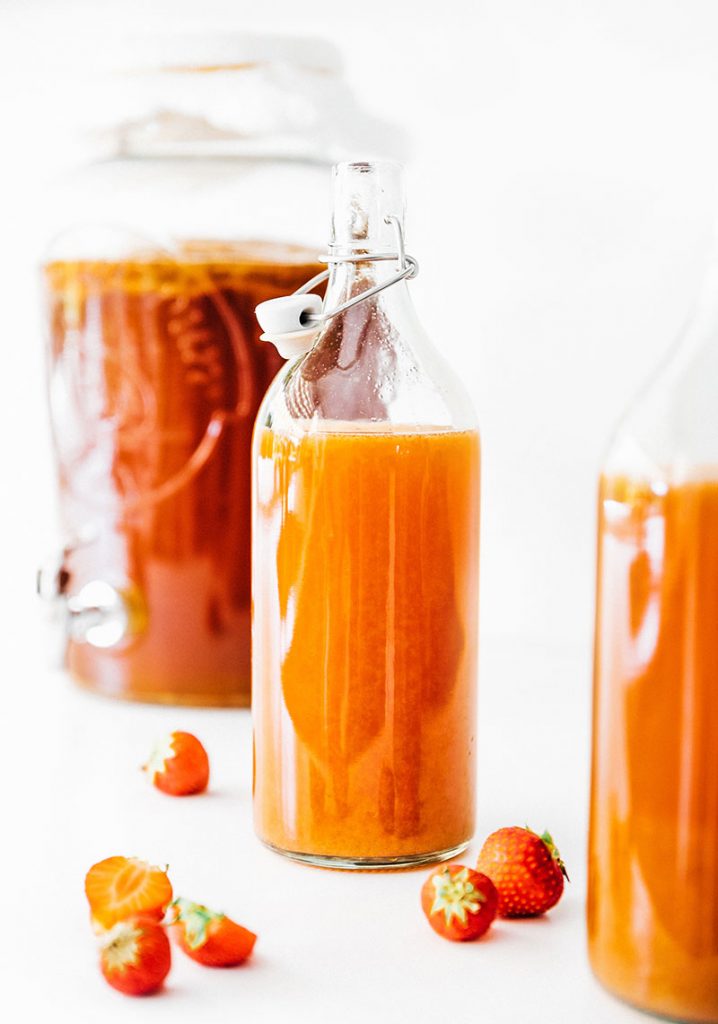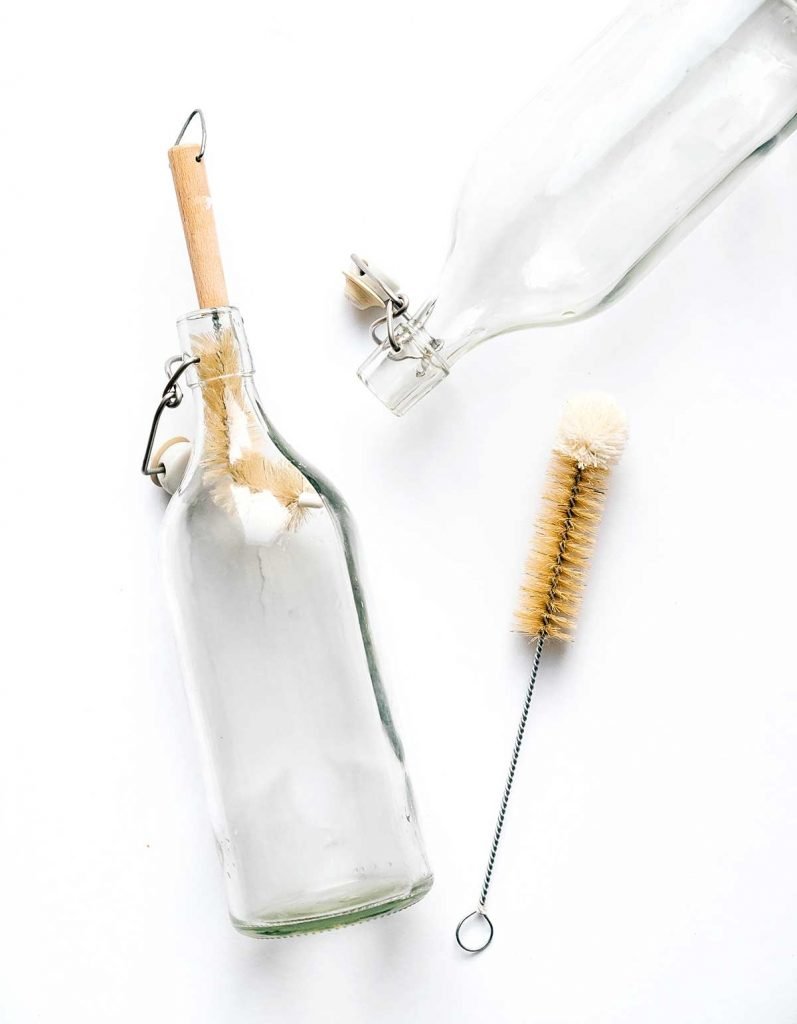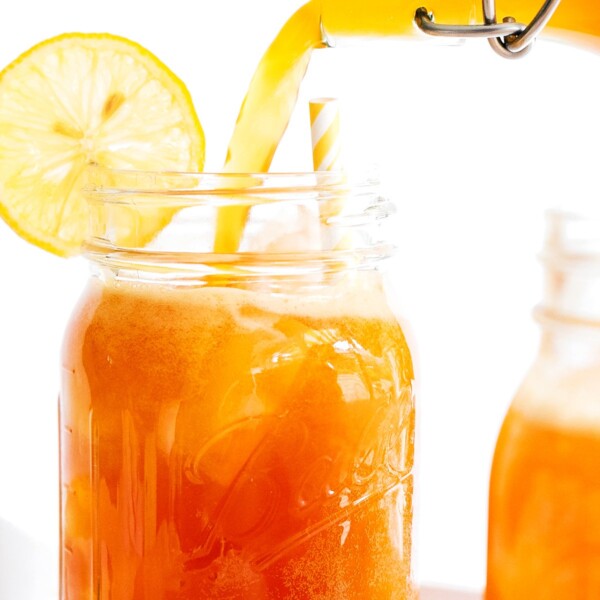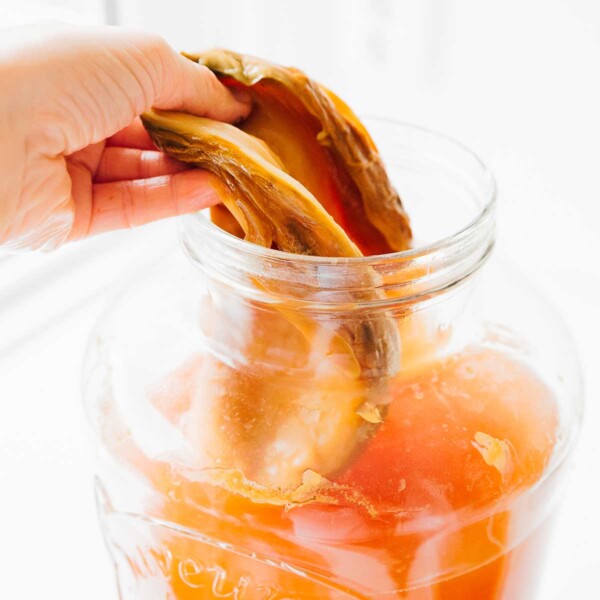Carbonation is the best part of brewing, but you’ll need quality kombucha bottles! Here’s how to determine the best bottles for kombucha home brewing.

It doesn’t take much to create amazingly fizz kombucha at home. You’ll basically just need: sugar, tea, kombucha, a SCOBY, and some quality jars and bottles!
In the first fermentation you make the kombucha using a large breathable jar. In the second fermentation you carbonate the kombucha by transferring it to fermentation-grade bottles and sealing them shut. This traps the carbon dioxide, forcing it into the liquid and creating a bubbly drink!
Today we’ll be focusing on the second fermentation, specifically, what the heck constitutes a “fermentation-grade bottle”?

Why you need good bottles for fermenting
It’s important that we use good quality bottles that are meant for fermentation when brewing kombucha. These produce better kombucha by trapping in all the carbonation, even when under pressure, making for a much more fizzy drink.
Good bottles are also important in terms of safety. Bottles meant for fermentation reduce the chance of explosions (rare but possible), as well as contamination.
Characteristics of good kombucha bottles
Glass: Glass is by far the most popular material amongst brewers. It doesn’t react with the highly acidic kombucha (like metals might), is scratch resistant (unlike plastic), and doesn’t contain potentially hazardous compounds (such as lead in ceramic, BPA in plastic, or heavy metals in metal). While you can use ceramic or porcelain in brewing, be sure that it is food-grade.
Air Tight: In order to carbonate kombucha in the second fermentation, the bottles need to be truly airtight. Flip (or swing) top bottles are best for this because they have a rubber seal to keep air in.
Hold Up To Pressure: As the bacteria and yeast eat up the sugars in the tea and create carbonation, and with no where for the carbonation to go, the pressure will build up inside the bottles. For this reason, it’s important to buy bottles that can withstand the pressure of fermentation. These have thicker glass and stronger caps. Aim for 58 psi.
Size: The size of your kombucha bottles is totally up to you, and won’t have a huge impact on quality. You can choose to bottle your kombucha in convenient single servings (like with these 16 oz bottles), or go with large bottles to make prep work easier (like with these 1 quart bottles).
Best Bottles For Kombucha
Here are a few of the best bottles for kombucha!
👉 SWING TOP GLASS BOTTLES (16-OZ) – A best-selling bottle that’s designed for home brewing.
👉 SWING TOP GLASS BOTTLES (33-OZ) – I personally prefer to use larger fermentation bottles, which make it easier to add flavors and move the bottles to my fermentation station (i.e. basement). These hold about 4 cups.
👉 GROLSCH GLASS BEER BOTTLES (16-OZ) – Another favorite amongst brewers, the Grolsch-style beer bottles are ultra-strong. (Pro-tip: if you can find a case of Grolsch beers in your area, just buy the case, drink the beer, and save the bottles!)
👉 WIDE MOUTH TWIST CAP BOTTLES (18-OZ) – While not as airtight or pressure proof as the flip-top bottles, many people prefer these wide mouth twist top bottles, which can be easier for adding fruit and bringing on the go.
(Pro-tip: save the bottles from store bought kombucha and use those instead – though you won’t be buying much kombucha from the store once you get your fermentation up and running!)
Bottles to avoid
There are a few things to look out for when choosing the perfect kombucha bottles.
Materials: Plastic should be avoided, as it is porous and can house nasty bacteria. Metal should also be avoided, as it can react with the kombucha and cause toxic compounds to leach into your brew. Finally, avoid crystal and non-food grade ceramic, which can contain lead.
Purpose: Watch out for “ornamental” bottles, which are nice for pouring water at your fancy dinner parties, but not great at holding the pressure of a kombucha fermentation. Similarly, mason jars are not great for brewing kombucha, as they aren’t truly air tight.
After you’ve picked your bottles, check out this article on how to clean your kombucha supplies before you start brewing!





Is it safe to drink fizzless flat kombucha?
I do not like wasting. During my second fermentation, I reused empthy storebought Kombucha bottles, then realized I was short one bottle and found another (decorative) glass bottle (obviously not the best quality). no fizz whatsoever. I tasted it. Tastes OK. Thinking to add it to a smoothie.
It’s totally safe! The only difference is that the carbonation left the kombucha rather than being trapped inside.
What about recycled beer bottles, with bottle caps and a capping tool? I know people do that for homebrewing beer. Think it would work here as well?
I haven’t tried this actually! I’m wondering if the beer cap would be able to hold up to the pressure. If you give it a go I’d love to hear about it!
This is how I bottle and it’s been working well. The beer cap is metal, but I leave a good header gap so no problems so far. Nice and fizzy when using good bottles and my capper.
I use the “Yellow Tail” Bubbles sparkling white wine self sealing bottles for my kombucha. It has a push down seal and twist to open.
I find it works well.
Only thing is you need to drink the contents to get the bottles or ask your friends to drink it for you. It is a nice light sparkling wine.
That’s my excuse to obtain the bottles.
Such a good idea, I’ll have to check those out!
can you use the same jug/large bottle from the first fermentation? they seem air tight with the plastic lid, but I wonder if it is too large to get bubbles?
Well you’ll want to keep your SCOBY somewhere else (it doesn’t go into the second fermentation), so it’s handy to have separate containers for the second ferm. But in theory, if it’s airtight and pressure rated then it could work!
Can I reuse bottles from store-bought kombucha? Also, can gallon glass jugs from fresh pressed cider be used? Will both of these types hold up to the pressure? Thank you.
Store bought bottles will be fine, though they won’t keep in quite as much carbonation as the flip top style bottles will. I’m not sure on the apple cider jug to be honest – if it’s flip top and pressure rated then probably yes.
How about a larger swing top glass jar rather than the 500ml or 1 liter smaller bottles? I did a 2 liter batch and bought a 3 liter sized swing top glass jar so I could do my second fermentation in that, couldn’t I? Same principle. Or will the large size have an impact?
That should work, though I haven’t personally tried it out. The only setback could be that when you pop it open to serve, you may lose carbonation. This would usually only impact a few cups of kombucha, but doing it this way could give you a lot more flat kombucha.
Wine bottles reused does not give a bubbly result. It is only flip top with rubber seal that provides the BBEST FIZZ. second hand bottles does not suffice.
Not exactly , I found a case of empty Grolsch bottles at the beer store,
disinfected them with alcohol, and they are awesome. I do the same with store bought kombucha and do the same process for them. Believe it or not these are my best and the labels are still holding strong after 2 yrs!! Somebody might even use the powders they sell for wine kits for extra assurance. Good hunting!!
I have some arthritis issues and I am having problems with the flip top bottles. Any suggestions on the easiest way to get them open?
Now THAT is a tough question! I did a search and can’t find any tools for it. The only thing I can think is to perhaps tie a string to the metal part that you would usually push open. then you can maybe pull the string to open? Otherwise perhaps twist top bottles would be best for you, with a tool to help open twist tops (I see a bunch on Amazon).
Would love to hear what ends up working for you!
maybe taking an old fork or butter knife and bending it into a hook to pull the tops open would help
That’s a great idea!
I’m not sure whether your arthritis affects just your knuckles or your entire hands, but my suggestion is based on the former. Cover the metal part that flips out with a towel, and using the palm/heel of your hand, PUSH it out (from behind) to open it. When it’s time to close it again, align everything as best you can, cover with the folded towel, and again, push it into position using the heel of your hand.
Wondered if I could use previously used screw top wine bottles for kombucha?
I haven’t tried this, but I don’t think these would be great. You can always try it, but I think the lid may be too weak to hold in the carbonation, so you might run a higher risk of explosions.
Thank you for helping me to know what and not to use. Just really great to know all that I read on your page. Keep the good work up.
Happy to hear it was helpful, Viki! 😀